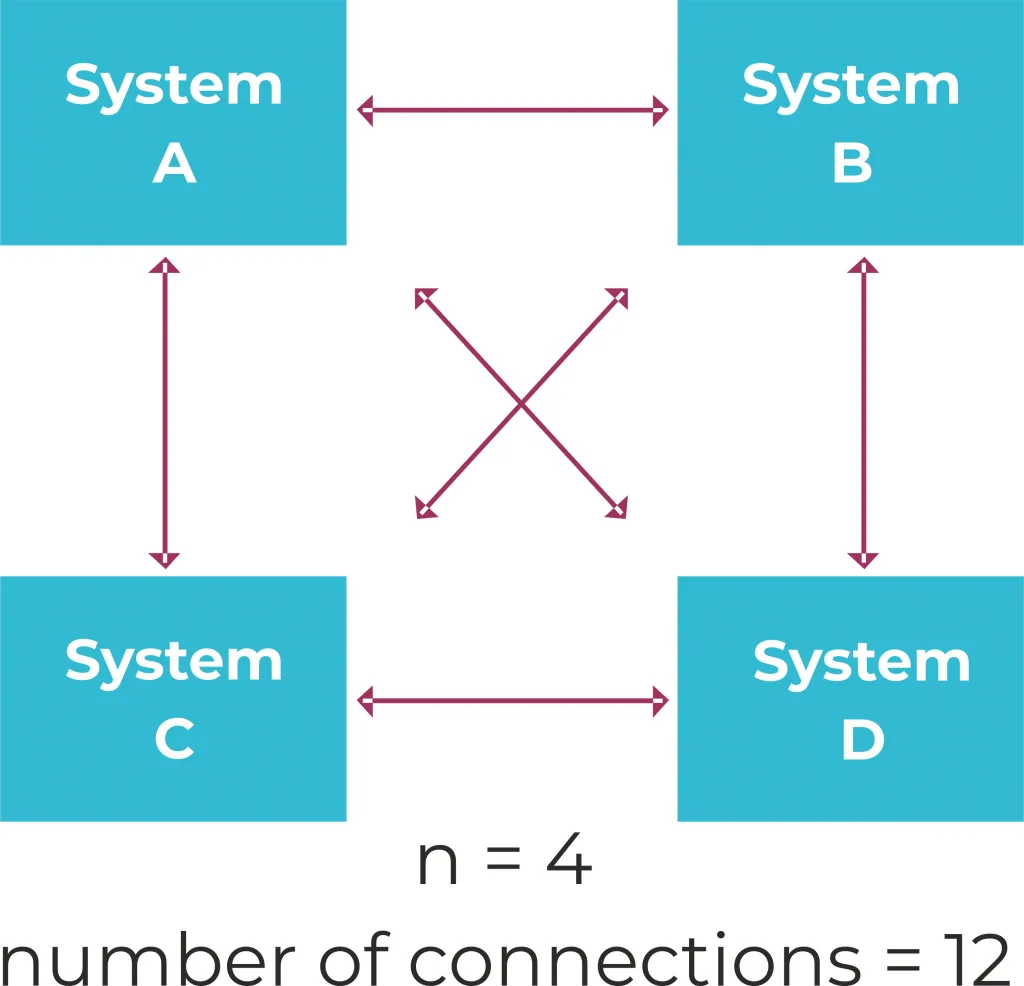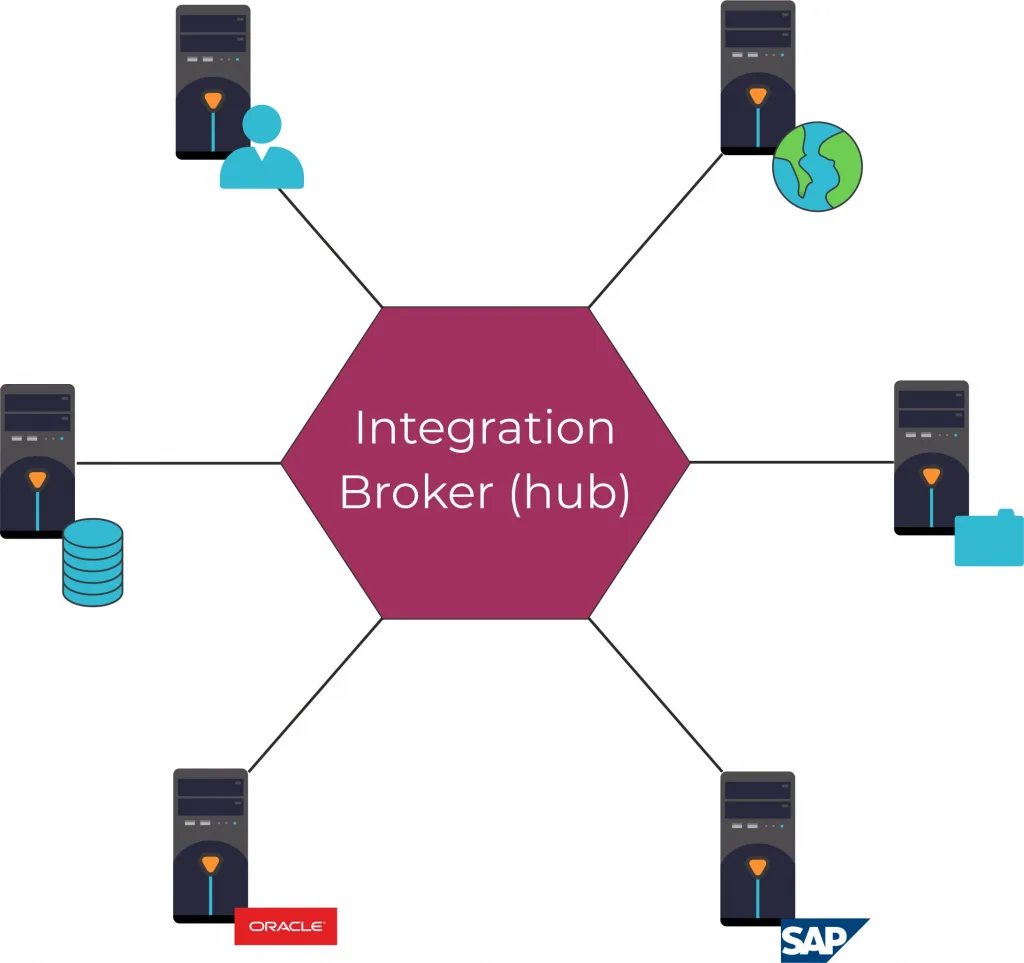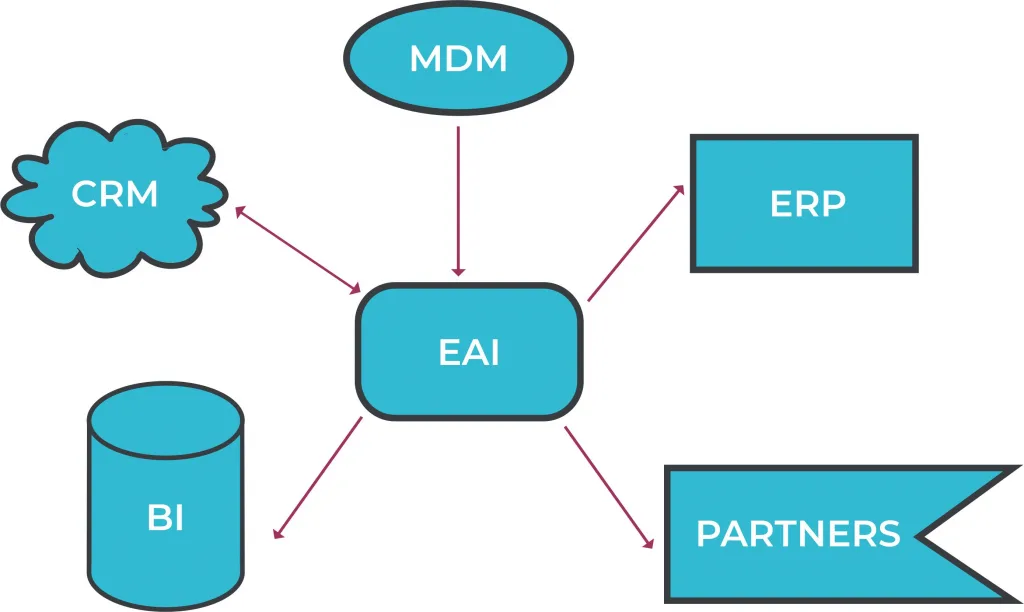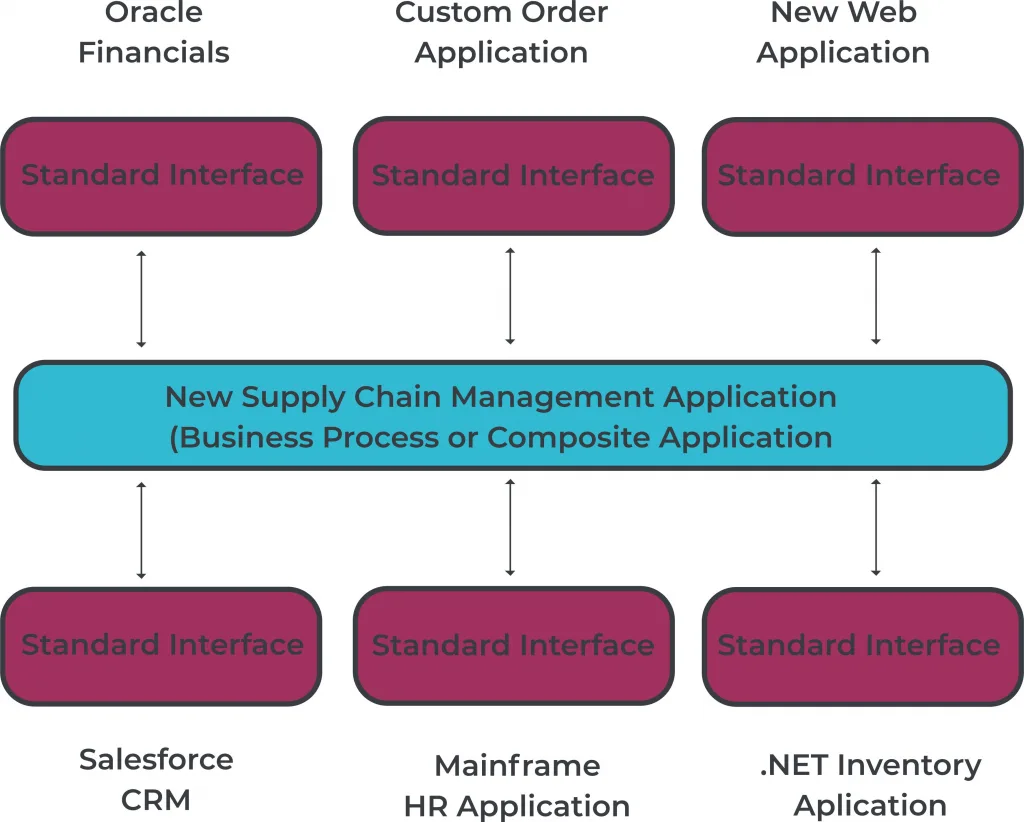- Overview
- What systems will be interconnected?
- Advantages and disadvantages of system integration
- What is the right system integration approach?
- Point-to-point system integration
- Point to point integration advantages and disadvantages
- Hub-and-spoke integration
- Enterprise application integration
- Service-oriented architecture
- When the approach is chosen, the integration design begins
- A couple of words on the implementation step
- Conclusions
Overview
There can be many pains related to software systems integration. These pains are typically related to the types of systems that should be integrated, the level of integration, and the overall complexity of the project.
The list of the most common challenges and pitfalls includes but is not limited to:
- data conversion and transformation
- interface design
- compatibility issues
- testing and validation of complexities
- documentation challenges
- and training efforts
We will consider some of the most significant disadvantages of data integration in more detail further in the text.
There are many different approaches to software system integration and each of them has its own advantages and disadvantages.
Among the most common system integration approaches, we should mention:
- point to point integration
- hub-and-spoke integration
- enterprise application integration
- and service-oriented architecture.
In this article, we’d like to dive deeper into each of them and have a look at how they can help integrate different software systems.
If you are looking for a reliable partner in legacy app modernization and integration, contact us. We will be happy to be of service to you.
What systems will be interconnected?
The first step to undertake even before initiating the actual software systems integration project is to choose the programs that need to be integrated and to define the overall scope of the integration project.
Although at first glance everything seems straightforward – after all, we just want system A to talk to and understand system B – on closer inspection, it becomes much more complicated. System A might have different subsystems, the same can be true about system B. And in this case, the integration matrix can become much bigger than 1:1.
The best way out in this case is to begin by outlining the business flows that should be covered by the unified integrated solution. First of all, you need to understand what organizational flows should receive better digitalization. Accordingly, you also need to know what forms that will be filled and by what roles, what workflows should cross the system boundaries, what data should be stored, and where.
Once we have an understanding of the desired user-acceptance level outcome, it is much easier to see which system A & B functionalities, data, and user interface must interact and in what way. Now we are ready to initiate the system integration project.
Advantages and disadvantages of system integration
When you are considering software systems integration, it is always crucial to evaluate and carefully analyze all the pluses and minuses of this project. Software system integration is a rather serious tech process that may cause significant issues if conducted without proper knowledge and diligent research of all the associated risks. That’s why we strongly recommend you devote enough time to considering your project with all the related benefits and pitfalls, as well as pay attention to various system integration approaches that are available in your case.
Advantages of system and application integration
- Better productivity. That’s probably the most obvious and the most important benefit, When an organization has a lot of different systems, programs, apps, and tools, all this can be very confusing for its employees. It usually takes too much time to switch from one system to another. Moreover, due to such inconveniences, users may also need to face a lot of repetitive tasks that can be easily avoided thanks to software application integration. When users have all the required data at hand in one program, their productivity is significantly higher.
- Lower maintenance costs. Every software requires maintenance and tech support. Without any doubt, all these services are associated with extra costs. When you have integrated systems, you can reduce maintenance costs as well as minimize the time required for conducting all the related activities.
- Improved analysis and management. When you have a lot of programs, it may be very challenging for you to analyze how your company is performing based on the data generated and collected by your software systems that work fully independently. However, thanks to software system integration, you can greatly facilitate and streamline these tasks. You will get a bigger picture and based on the results of the efficient analysis you will be able to make more informed business decisions.
Disadvantages of software systems integration
- Security concerns. Speaking about the pros and cons of system integration, it is impossible to skip the risk of security issues that may happen during this process. Of course, everything depends on the applied integration approaches and skills of the engineers who conduct it. Nevertheless, we should admit that from the perspective of security, quite often it is much more beneficial to have independent systems than integrated software. After software application integration if any fraudsters or hackers get access at least to one of the modules of your program, the entire system will be under threat. Moreover, the way your data moves from one module to another may also add extra risks.
- Cost. Among the disadvantages of data integration, we should mention the cost of this process. As software system integration is a rather specific task, it will require strong skills from the experts who will be responsible for it. Though this process may help you save money on maintenance services, the cost of software application integration rather often can be comparable with the cost of custom app development projects.
- Challenges related to system modernization. Regardless of the chosen system integration methods, this process won’t transform all your programs into a single one, they will be just tied. That’s why when you need to upgrade your systems, you will need to deal with them separately. It’s important to bear in mind that it can be a rather time- and effort-consuming task.
Should all these drawbacks stop you from thinking about software system integration? Given our experience in relying on all common data integration approaches in different projects, we do not think so. They should make you consider the feasibility of software systems integration for your business more attentively but not discourage to continue planning it.
Moreover, let us highlight that while one decision can be fully correct for one company, it doesn’t mean that it will be the right way out for yours. In our practice, we had different cases when, for example, after viewing the advantages and disadvantages of integrated accounting system, some businesses agreed to proceed to software system integration, while others decided not to invest in such a project.
What is the right system integration approach?
The next step that is a part of the architectural design is to choose the right system integration approach for the project. Let’s shortly describe each of the most common system integration types.
Point-to-point system integration
To begin with, let us answer to the most obvious question in this context. “What is point to point integration?”
Point-to-point software system integration is the process of connecting two or more software systems so that they can share data and functionality. This can be done either through direct connections between the systems or by using a middleware system that acts as an intermediary between the systems that should be integrated.
An example of a point-to-point software system integration would be the following one. Let’s suppose that you have a customer information system and an accounting system, and you want to integrate them so that customer information can be automatically added to the accounting system. In that case, you need to ensure that these two systems are intimately aware of each other, know the APIs, and addresses of the relevant user interfaces, and maybe can even directly access each others’ data.
Point to point integration advantages and disadvantages
When you start considering different types of software integration, you will see that all of them will have their strong and weak sides. And point to point integration is definitely not an exception. Let’s have a look at them.
There are a few key advantages of point-to-point integration:
- It is relatively simple to set up and configure.
- It is often less expensive than other integration methods.
- It can be easily customized to meet the specific needs of each system.
However, there are also some significant disadvantages of point-to-point integration:
- It can be difficult to maintain and upgrade.
- It can be inflexible, making it difficult to introduce changes to each of the systems.
- It can be unreliable, as each connection is a single point of failure.

Hub-and-spoke integration
The next point that we will mention on our list of application integration approaches will be hub-and-spoke integration. It presupposes that an integration hub acts as a central point of communication and connectivity for a group of disparate systems. The hub is responsible for mediating communication between the systems and providing a common data model and integration framework.
The spoke systems connect to the hub and communicate with each other through this hub. The Hub-and-spoke approach is a popular choice for integrating a large number of disparate systems because it is scalable and it provides a high degree of flexibility. The hub can be used to connect a wide variety of systems, including legacy systems, and the spoke systems can be implemented using a variety of technologies.
In a hub-and-spoke integration, data is collected from various sources and then centralized in a single location (the “hub”). The hub then distributes the data to the various “spokes” or applications that need it. This type of integration is often used in data warehouses, where data from various sources is collected and then used for reporting and analysis.
The key advantages of hub-and-spoke software system integration are the following:
- It can be very cost-effective because it eliminates the need to duplicate systems and data.
- It can improve data quality and consistency because data is entered only once and then shared with all connected systems.
- It can be rather simple to maintain because there is only one system to update and manage.
We also need to mention some disadvantages of hub-and-spoke software system integration:
- It can be complex to set up and manage, especially if there is a large number of systems involved.
- It can be difficult to add new systems to the integration because they need to be compatible with the existing hub.
- There is a risk of data loss or corruption if the hub goes down or is not working properly.

Enterprise application integration
Among other system integration types, we shouldn’t omit enterprise application integration. It is the process of linking together different applications within a business in order to share data and information. This can be done through a variety of means, such as software that allows different applications to communicate with each other, or by physically connecting different computer systems. The goal of enterprise application integration is to make it easier for businesses to organize data sharing between different departments and systems, in order to improve efficiency and collaboration.
An example of enterprise application integration is the process of integrating an organization’s CRM system with its accounting system. This software system integration can allow data to flow between the two systems automatically, making it faster and more comfortable for employees to access information and work with data from both systems.
Below you can see some software products pairs, which play well within an enterprise application integration solution:
- Salesforce.com and SAP
- SAP and Oracle
- Oracle and Microsoft Dynamics
- Microsoft Dynamics and Salesforce.com
There are many potential benefits of enterprise application integration, including increased efficiency, greater data accuracy, and improved decision-making. However, there are also some potential drawbacks, such as increased complexity and the need for specific skills.

Service-oriented architecture
Service-oriented architecture (SOA) is a software development approach that defines an application as a collection of services that communicate with each other. Services are small, self-contained programs that can be accessed over a network, usually through an API.
SOA is a way to design software so that it is modular and reusable. This makes it easier to develop, deploy, and manage applications. It also makes it less challenging to integrate applications with each other.
SOA is not a specific technology, but rather a design approach. However, there are many technologies that are commonly used in SOA, such as web services, XML, and SOAP.
A Service-oriented architecture solution is a system that is designed to provide services to users. The system can be composed of a number of different components, each of which is responsible for providing a different service. The system is designed to be highly modular so that new services could be easily added or existing ones can be modified.
The range of advantages of using an SOA solution includes the following ones:
- Services can be independently deployed and updated.
- Services can be reused in different applications.
- Services can be composed to create new applications.
- Services can be loosely coupled, so that changes in one service do not affect other services.
The list of challenges related to using an SOA solution includes such points as:
- Services need to be well-designed and well-documented.
- Services need to be discoverable.
- Services need to be interoperable.
- There can be a performance overhead when invoking a remote service.

When the approach is chosen, the integration design begins
After common system integration approaches have been thoroughly looked into, analyzed, and discussed – all in accordance with the systems that should be integrated and the expected business flows changes – it is time to make up your mind.
Once the winner has been chosen, you need to dive deeper into the detailed integration design and analyze other topics like:
- Integration of auxiliary products and services to be used. There is a plethora of such software, which reduces complexity, decreases time to market, and leads the integration according to the best practices.
- Software development technologies most fitting the systems and the integration in sight. You need to take into account what development teams you have or plan to recruit, what existing software components have been developed and can be reused, etc.
- Automatic testing of the integration. As it comes out of the developers’ hands, it is required to ensure that the integration is robust and fulfills the business definitions. Failing to build the tests into the delivery pipeline can lead to Pandora’s box opening right at the end of the project.
A couple of words on the implementation step
At this point it may seem to you that everything is ready: the design is chosen, all other choices are made, people are hired, and the work has begun. However, reality rarely 100% fits the plans, as we all know. It means that integration design and other decisions can change along the way.
Be prepared for this, consider new contributions objectively, and adjust integration projects and development plans accordingly.
When you work in such a way, the final system will have the biggest chance to correspond to the business expectations.
Conclusions
There are many things that you may find frightening at first glance. Systems may seem hard to integrate, they may have disparate technologies, very different internal architectures, complex data, misfitting flows, etc.
That’s why a multitude of diverse software system integration patterns and approaches have been developed over the years. At the current moment, they have been already tested by real projects, enhanced, and made known to others.
That’s why a multitude of diverse software system integration patterns and approaches have been developed over the years. At the current moment, they have been already tested by real projects, enhanced, and made known to others.
As a result, the best approach to system design is to collect as much input data, both business and technological, as possible in order to find the most appropriate decisions that will correspond to the business, the organization, its current and future goals, and capabilities.
We are also experts in software migrations. You can contact us so we can discuss your project.







